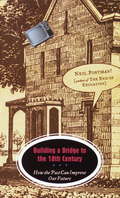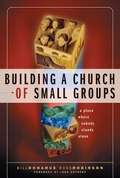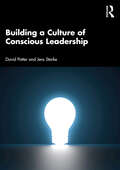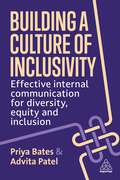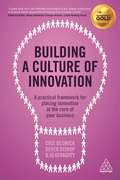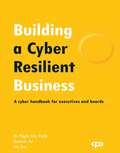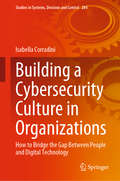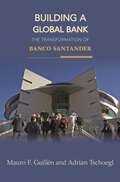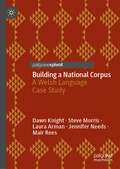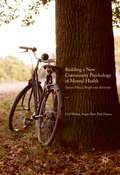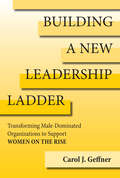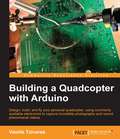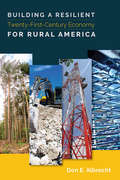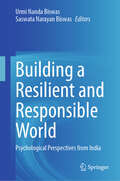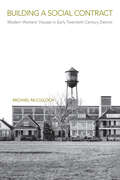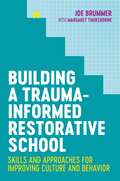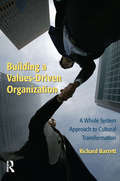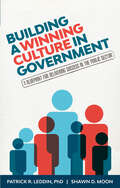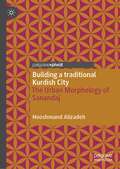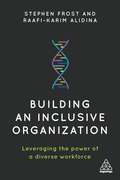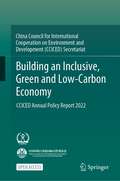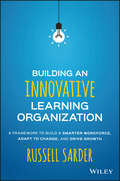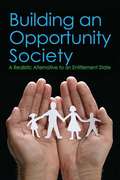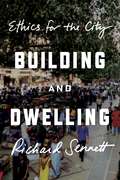- Table View
- List View
Building a Bridge to the 18th Century
by Neil PostmanAt a time when we are reexamining our values, reeling from the pace of change, witnessing the clash between good instincts and "pragmatism," dealing with the angst of a new millennium, Neil Postman, one of our most distinguished observers of contemporary society, provides for us a source of guidance and inspiration. In Building a Bridge to the Eighteenth Century he revisits the Enlightenment, that great flowering of ideas that provided a humane direction for the future -- ideas that formed our nation and that we would do well to embrace anew.He turns our attention to Goethe, Voltaire, Rousseau, Diderot, Kant, Edward Gibbon, Adam Smith, Thomas Paine, Jefferson, and Franklin, and to their then-radical thinking about inductive science, religious and political freedom, popular education, rational commerce, the nation-state, progress, and happiness.Postman calls for a future connected to traditions that provide sane authority and meaningful purpose -- as opposed to an overreliance on technology and an increasing disregard for the lessons of history. And he argues passionately for specific new guidelines in the education of our children, with renewed emphasis on developing the intellect as successfully as we are developing a computer-driven world.Witty, provocative, and brilliantly reasoned, Building a Bridge to the Eighteenth Century is Neil Postman's most radical, and most commonsensical, book yet.From the Hardcover edition.
Building a Church of Small Groups
by Russ Robinson Bill DonhueChurch Should Be the Last Place Where Anyone Stands AloneOur hearts were made for deep, authentic relationships. For community. And like nothing else, small groups provide the kind of life-giving community that builds and empowers the body of Christ and impacts the world. At Willow Creek Community Church, small groups are so important that they define the core organizational strategy. Willow Creek has gone from being a church with small groups to being a church of small groups. Sharing insights from that transition, its two chief architects tell how your church-whatever its size and circumstances-can become a place where people of all ages can experience powerful, transforming community. Part one presents the theological, sociological, and organizational underpinnings of small groups. You'll discover why they are so vital to church health. Part two moves you from vision to practice. Part three shows you how to identify, recruit, train, and support group leaders. And part four helps you deal with the critical process of change as your church develops its small group ministry. "Bill Donahue and Russ Robinson have not just thought and read and talked about community. They have rolled up their sleeves and devoted their vocational lives to figuring out how to actually help make it happen with real-life people in a real-life church. "-John Ortberg, author, If You Want to Walk on Water, Get Out of the Boat
Building a Co-operative Community in Public Housing
by Jorge SousaPublic housing projects were the original form of government supported housing for low-income residents. Over the last fifty years many projects have struggled with high crime rates and numerous social problems. One solution proposed to address these ongoing issues is granting residents decision-making power within their community by converting into a co-operative. Building a Co-operative Community in Public Housing follows the journey of a Toronto public housing complex as it was converted into a resident-operated co-operative, a first in Canada.Jorge Sousa traces the story of Alexandra Park, which became the Atkinson Housing Co-operative in 2003 after a ten-year conversion process. Sousa, who himself was raised in the community, provides an empirical account of the contributing factors that influenced its decision to pursue community-based control, as well as the experiences of both residents and government officials engaged in this process. Finally, Building a Co-operative Community in Public Housing offers a framework for other communities facing similar circumstances who want to learn how to go about undertaking this process.All royalties from this book will be contributed to the Co-operative Housing Federation of Toronto Charitable Fund.
Building a Culture of Conscious Leadership
by David Potter Jens StarkeA significant driver of disengagement amongst employees is a lack of psychological safety generated from weak and underdeveloped intra- and interpersonal skills on the part of managers. Addressing the issue head on, this book enables leaders to lead with conscious awareness to build and sustain psychologically safe cultures through which team members may positively engage with work in a far more meaningful and purposeful way. All too often, leadership-follower relationships are purely transactional and focus on errors and problems, resulting in an impoverished transactional leadership culture. These dynamics result in weak rapport, low levels of emotional intelligence on the part of line managers and, subsequently, employee disengagement. This book unpacks these drivers in detail and builds a model that can be used as the basis of personal development and as a large-scale intervention into the leadership culture of an organisation. This model is very accessible and can be used in a structured training programme through a series of action learning workshops based upon coaching relationships and mutual dialogue. The book is ideal reading for HRM managers, change leaders, learning and development managers, students of management and leadership, and line managers in organisations who are involved in leadership roles.
Building a Culture of Inclusivity: Effective Internal Communication For Diversity, Equity and Inclusion
by Priya Bates Advita PatelDiversity, equality and inclusion (DEI) have never been so important in organizations and yet many feel inadequately prepared. In this guide, the authors combine their expert knowledge to provide a practical approach to bridge this skills and knowledge gap for those delivering Internal Communications. Navigating DEI language can be difficult, but Building a Culture of Inclusivity will help Internal Communication professionals, HR and business leaders engage employees in driving culture change to ensure everyone feels valued and like they belong. This book provides a roadmap to manage tangible change consistently throughout the year and techniques that avoid inauthenticity. It also explains how to identify and move away from performative tokenistic actions and biases to help develop effective deliverables that help every colleague in their organization feel included. This book offers support for conversations with leaders to help them drive the diversity agenda and understand the importance of cultivating a culture of inclusivity across their workforce through their internal communications. Inherently practical, Building a Culture of Inclusivity provides case studies of exemplar DEI communications, exercises for self-assessment and templates to complete to identify goals and strategies. Written by two experienced Internal Communication Professionals, this book will help you understand how to construct and sustain an inclusive workplace where progress leads to results.
Building a Culture of Innovation
by Derek Bishop Jo Geraghty Cris BeswickBeing a truly innovative company is more than the dreaming up of new products and services by external consultants and internal taskforces. Staying one step ahead of the competition requires you to embed innovation into your organizational culture. Innovation needs to be embodied in everything that gets done by everyone who works there. By changing your organizational culture to one that supports innovation, you will remove the barriers that stop you responding quickly and agilely to changing market conditions and opportunities for growth. Building a Culture of Innovation presents a practical framework that you can follow to design and embed a culture of innovation in your business.The six-step Innovation Culture Change Framework offers a structured process to make change stick, from assessing your organization's innovation-readiness to leading a managed change process that will foster innovation at each level. It includes case studies from international organizations which have shifted their focus to an innovation culture, including Prudential, Qinetiq, Octopus Investments, Cisco, Siemens, BrightMove Media, Waitrose and Feefo. Supported with downloadable resources, Building a Culture of Innovation is an essential read for business leaders and change implementation teams who want to place innovation at the heart of their business strategy.
Building a Cyber Resilient Business: A cyber handbook for executives and boards
by Shamane Tan Hai Tran Dr. Magda ChellyLearn how to build a proactive cybersecurity culture together with the rest of your C-suite to effectively manage cyber risksKey FeaturesEnable business acceleration by preparing your organization against cyber risksDiscover tips and tricks to manage cyber risks in your organization and build a cyber resilient businessUnpack critical questions for the C-suite to ensure the firm is intentionally building cyber resilienceBook DescriptionWith cyberattacks on the rise, it has become essential for C-suite executives and board members to step up and collectively recognize cyber risk as a top priority business risk. However, non-cyber executives find it challenging to understand their role in increasing the business's cyber resilience due to its complex nature and the lack of a clear return on investment.This book demystifies the perception that cybersecurity is a technical problem, drawing parallels between the key responsibilities of the C-suite roles to line up with the mission of the Chief Information Security Officer (CISO).The book equips you with all you need to know about cyber risks to run the business effectively. Each chapter provides a holistic overview of the dynamic priorities of the C-suite (from the CFO to the CIO, COO, CRO, and so on), and unpacks how cybersecurity must be embedded in every business function. The book also contains self-assessment questions, which are a helpful tool in evaluating any major cybersecurity initiatives and/or investment required.With this book, you'll have a deeper appreciation of the various ways all executives can contribute to the organization's cyber program, in close collaboration with the CISO and the security team, and achieve a cyber-resilient, profitable, and sustainable business.What you will learnUnderstand why cybersecurity should matter to the C-suiteExplore how different roles contribute to an organization's securityDiscover how priorities of roles affect an executive's contribution to securityUnderstand financial losses and business impact caused by cyber risksCome to grips with the role of the board of directors in cybersecurity programsLeverage the recipes to build a strong cybersecurity cultureDiscover tips on cyber risk quantification and cyber insuranceDefine a common language that bridges the gap between business and cybersecurityWho this book is forThis book is for the C-suite and executives who are not necessarily working in cybersecurity. The guidebook will bridge the gaps between the CISO and the rest of the executives, helping CEOs, CFOs, CIOs, COOs, etc., to understand how they can work together with the CISO and their team to achieve organization-wide cyber resilience for business value preservation and growth.
Building a Cybersecurity Culture in Organizations: How to Bridge the Gap Between People and Digital Technology (Studies in Systems, Decision and Control #284)
by Isabella CorradiniThis book offers a practice-oriented guide to developing an effective cybersecurity culture in organizations. It provides a psychosocial perspective on common cyberthreats affecting organizations, and presents practical solutions for leveraging employees’ attitudes and behaviours in order to improve security.Cybersecurity, as well as the solutions used to achieve it, has largely been associated with technologies. In contrast, this book argues that cybersecurity begins with improving the connections between people and digital technologies. By presenting a comprehensive analysis of the current cybersecurity landscape, the author discusses, based on literature and her personal experience, human weaknesses in relation to security and the advantages of pursuing a holistic approach to cybersecurity, and suggests how to develop cybersecurity culture in practice. Organizations can improve their cyber resilience by adequately training their staff. Accordingly, the book also describes a set of training methods and tools. Further, ongoing education programmes and effective communication within organizations are considered, showing that they can become key drivers for successful cybersecurity awareness initiatives. When properly trained and actively involved, human beings can become the true first line of defence for every organization.
Building a Global Bank: The Transformation of Banco Santander
by Mauro F. Guillén Adrian TschoeglIn 2004, Spain's Banco Santander purchased Britain's Abbey National Bank in a deal valued at fifteen billion dollars--an acquisition that made Santander one of the ten largest financial institutions in the world. Here, Mauro Guillén and Adrian Tschoegl tackle the question of how this once-sleepy, family-run provincial bank in a developing economy transformed itself into a financial-services group with more than sixty-six million customers on three continents. Founded 150 years ago in the Spanish port city of the same name, Santander is the only large bank in the world where three successive generations of one family have led top management and the board of directors. But Santander is fully modern. Drawing on rich data and in-depth interviews with family members and managers, Guillén and Tschoegl reveal how strategic decisions by the family and complex political, social, technological, and economic forces drove Santander's unprecedented rise to global prominence. The authors place the bank in this competitive milieu, comparing it with its rivals in Europe and America, and showing how Santander, faced with growing competition in Spain and Europe, sought growth opportunities in Latin America and elsewhere. They also address the complexities of managerial succession and family leadership, and weigh the implications of Santander's stellar rise for the consolidation of European banking. Building a Global Bank tells the fascinating story behind this powerful corporation's remarkable transformation--and of the family behind it.
Building a National Corpus: A Welsh Language Case Study
by Mair Rees Dawn Knight Steve Morris Laura Arman Jennifer NeedsThis book aims to provide a micro-level, working model of a methodological approach and practical guidelines for building a corpus, informed by the work on the CorCenCC project (Corpws Cenedlaethol Cymraeg Cyfoes - the National Corpus of Contemporary Welsh). It focuses specifically on the development of detailed design frames for corpora across communicative modes (spoken, written and e-language), and the practical processes involved in the planning, collection, transcription, collation and (re)presentation of language data. The book is designed to be of significant value and relevance to those interested in critically engaging with corpus methodology. Although Welsh is the language under discussion, the processes and approaches discussed in the building of CorCenCC can be applied to a lesser or greater extent to other language contexts. This book provides a working model, and an account of how to build a corpus dataset from which step by step guidelines for creating other linguistic corpora in any language can be easily extrapolated. It will be of value to students and scholars of minority languages and corpus linguistics.
Building a New Community Psychology of Mental Health: Spaces, Places, People and Activities
by Carl Walker Angie Hart Paul HannaThis book provides a much-needed account of informal community-based approaches to working with mental distress. It starts from the premise that contemporary mainstream psychiatry and psychology struggle to capture how distress results from complex embodied arrays of social experiences that are embedded within specific historical, cultural, political and economic settings. The authors challenge mainstream understandings of mental health that position a naive public in need of mental health literacy. Instead it is clear that a considerable amount of invaluable mental distress work is undertaken in spaces in our communities that are not understood as mental health treatments. This book represents one of the first attempts to position these kinds of spaces at the center of how we understand and address problems of mental distress and suffering. The chapters draw on case studies from the UK and abroad to point toward an exciting new paradigm based on informal community and socially oriented approaches to mental health. Written in an unusually accessible and engaging style, this book will appeal to social science students, academics, practitioners and policy makers interested in community and social approaches to mental health.
Building a New Leadership Ladder: Transforming Male-Dominated Organizations to Support Women on the Rise
by Carol J. GeffnerStrategies for transforming workplace cultures to support a new generation of women leaders.When it comes to the gender gap, it is not enough to ask women to &“lean in&” and demand promotions and raises. Organizations have an obligation to level up and provide women with more opportunities for advancement. In this book, leadership and governance expert Carol Geffner makes a strong case that for women to reach their full potential, workplaces and their leaders must take a more proactive role in combating gender discrimination.Based on over 200 hours of interviews with women leaders in the United States and abroad, Building a New Leadership Ladder demonstrates that even when women are promoted to leadership positions, they are rarely given access to the same support networks as their male colleagues. Covering sectors as diverse as higher education, health care, law enforcement, and the military, the book identifies common strategies that all organizations can use to remove obstacles for women&’s advancement.More than a how-to guide on how women can ascend to the top, Building a New Leadership Ladder is a bold call to action for organizations and their leaders to proactively foster the conditions under which women&’s efforts to rise up are consistently recognized and rewarded.Interviewer:Dr. Carol Geffner, Director of the Executive Master of Leadership Program at the USC&’s Sol Price School of Public Policy Interviewees:Alma Burke, former LAPD, currently head of security at USCYasmin Beers, former City Manager, Glendale, CARaShall Brackney, Chief of Police, Charlottesville, VACoco Brown, CEO Athena Alliance (SaaS company for HR)Mary Sue Coleman, chemist, interim president of University of Michigan (she previously served as president from 2002-2014)France Cordova, director of National Science FoundationTiffany Felix, Senior Vice President, Environmental Health and Safety, ParamountJennifer Grasso, LAPD&’s first female SWAT officerHeidi Hammel, Executive Vice President of the Association of Universities for Research in AstronomyStephanie Jarvis, (couldn&’t immediately confirm her current role)Nannerl Keohane, former president of Wellesley College and Duke UniversityFiona Ma, California State TreasurerAnni Mu, Deputy Group Commander, CA Air National GuardLaura Mosqueda, Professor of Family Medicine and Geriatrics at USC Keck School of MedicineJanet Napolitano, former Arizona governor, former Secretary of Homeland SecuritySharon Papa, Chief of Police, Hermosa Beach, CAEllen Stofan, Under Secretary for Science and Research, The SmithsonianMirtha Villereal-Younger, multiple leadership roles within CA military, currently President/CEO of Agile ConstructionHiltrud Werner, Volkswagen Board memberJoy White, Executive Director of the Air Force Space and Missile Systems CenterMaria Zuber, Vice President of Research, MITIn addition, three women were interviewed who, due to the nature of their positions and sectors, asked that they not be identified in this book.
Building a Quadcopter with Arduino
by Vasilis TzivarasDesign, build, and fly your personal quadcopter using market electronics to capture incredible photographs and record phenomenal videosAbout This BookGrasp the knowledge required to assemble your drone with light and cost effective materialsEnlighten your understanding about the flight by performing step-by-step pre-flight adjustments and acquiring the instructions for a safe flightGet the best tips to deal with performance issues related to your quadcopterWho This Book Is ForThis book is intended for hobbyists who are looking forward to fulfill their dream of flying a quadcopter clearly made by them. Some basic experience in electronic circuits and aerial vehicles will make it easier for you, however it isn't mandatory.What You Will LearnReview and choose the most suitable material for the buildSet up and calibrate all of your electronic partsControl and fly your quadcopter taking into account the weather conditionsMaintain your vehicle as much as possible and repair it whenever requiredEngineer the structure of your vehicleDevelop a flight controller with its basic principlesEliminate possible malfunctions in the futureRepair your drone if it crashes or faces any damageIn DetailQuadcopters, also known as quadrotors, are gaining more and more popularity in today's world. With the help of these devices, anyone can have an "eye in the sky" and can monitor any place at any time. You can capture photographs and once a while and perform automated tasks. In this book, you will be informed about all the basic modules and electronics needed to fly a simple quadcopter. You'll delve deep to create a fully-functional quadcopter quickly with the help of Arduino boards. Through this book, you'll develop the skills needed to build a DIY drone that can capture pictures and record videos.Style and approachThis is an easy-to-follow guide with pictorial depictions and technical descriptions to assemble your vehicle.
Building a Resilient Twenty-First-Century Economy for Rural America
by Don E. AlbrechtIn Building a Resilient Twenty-First-Century Economy for Rural America, Don E. Albrecht visits rural communities that have traditionally been dependent on a variety of goods-producing industries, explores what has happened as employment in these industries has declined, and provides a path by which they can build a vibrant twenty-first-century economy. Albrecht describes how structural economic changes led rural voters to support Donald Trump in the 2016 election and why his policies will not relieve the economic problems of rural residents. Trump’s promises to restore rural industrial jobs simply cannot be fulfilled because his policies do not address the base cause for this job loss—technological change, the most significant factor being the machine replacement of human labor in the production process. Bringing a personal understanding of the effects on rural communities and residents, Albrecht focuses each chapter on a community that has traditionally been economically dependent on a single industry—manufacturing, coal mining, agriculture, logging, oil and gas production, and tourism—and the consequences of losing that industry. He also lays out a plan for rebuilding America’s rural areas and creating an economically vibrant country with a more sustainable future. The rural economy cannot return to the past as it was structured and instead must look to a new future. Building a Resilient Twenty-First-Century Economy for Rural America describes the source of economic concerns in rural America and offers real ways to address them. It will be vital to students, scholars, practitioners, community leaders, politicians, and policy makers concerned with rural community development.
Building a Resilient and Responsible World: Psychological Perspectives from India
by Urmi Nanda Biswas Saswata Narayan BiswasThis volume extensively examines the current psycho-social challenges individuals and groups face in building a responsible society. It challenges the norms of social influence research, focusing on processes that drive responsible organizations and societal advancement. It delves into the layers of influence that shape our societies. It also spotlights the practical complexities of implementing government schemes, mainly focusing on Persons with Intellectual and Developmental Disabilities (PwIDDs). This volume uncovers the driving forces behind societal evolution and the strategies that harness responsible influence for a more inclusive and progressive future. Chapters in this contributed volume present theoretical contributions and results of empirical research from different disciplines, such as applied social and cognitive psychology, organizational psychology, cultural psychology, health psychology, educational psychology, life-span development, and are grouped into four thematic sections. The first part of the book brings together chapters discussing culture, diversity and inclusivity. The second part highlights issues of gender equity and resilience in Indian society. The third part focuses on health and well-being, Finally, the fourth part discusses resilient and responsible behavior in everyday social contexts. The book offers valuable insights into addressing social-psychological challenges individuals and groups face, promoting resilient and sustainable behavior towards a responsible society. It is a valuable resource for researchers in the fields of psychology, as well as for educators and teachers interested in knowing more about social psychological issues related to equity, diversity, and inclusivity within the Indian context.
Building a Social Contract: Modern Workers' Houses in Early-Twentieth Century Detroit (Urban Life, Landscape and Policy)
by Michael McCullochThe dream of the modern worker’s house emerged in early twentieth-century America as wage earners gained access to new, larger, and better-equipped dwellings. Building a Social Contract is a cogent history of the houses those workers dreamed of and labored for. Michael McCulloch chronicles the efforts of employers, government agencies, and the building industry who, along with workers themselves, produced an unprecedented boom in housing construction that peaked in the mid-1920s. Through oral histories, letters, photographs, and period fiction, McCulloch traces wage earners’ agency in negotiating a new implicit social contract, one that rewarded hard work with upward mobility in modern houses. This promise reflected workers’ increased bargaining power but, at the same time, left them increasingly vulnerable to layoffs. Building a Social Contract focuses on Detroit, the quintessential city of the era, where migrant workers came and were Americanized, and real estate agents and the speculative housebuilding industry thrived. The Motor City epitomized the struggle of Black workers in this period, who sought better lives through industrial labor but struggled to translate their wages into housing security amid racist segregation and violence. When Depression-era unemployment created an eviction crisis, the social contract unraveled, and workers rose up—at the polls and in the streets—to create a labor movement that reshaped American capitalism for decades. Today, the lessons McCulloch provides from early twentieth-century Detroit are a necessary reminder that wages are not enough, and only working-class political power can secure affordable housing.
Building a Trauma-Informed Restorative School: Skills and Approaches for Improving Culture and Behavior
by Joe BrummerCovering both theory and practice, this book will teach educators everything they need to know about developing restorative practices in their education settings, in a way that is also trauma-informed.The first part of the book addresses the theory and philosophy of restorative approaches, and of trauma-informed and trauma-sensitive schools. The second part outlines the five restorative skills (mindfulness, honest expression, empathy, the art of asking questions and the art of requests), what they look like in practice (including using circles, respect agreements and restorative dialogue), and how to implement them. Every strategy is clearly explained and adapted to be appropriate for children and adults who have experienced trauma.Everything the book discusses has been especially designed to be adapted for different school settings and their particular challenges.
Building a Values-Driven Organization
by Richard BarrettRichard Barrett, author of the best-selling book Liberating the Corporate Soul, presents his new thinkingBased on his experience working with over 1,000 organizations in 32 countries on cultural transformation for the values-driven organization. He presents a whole system approach to cultural transformation, showing organizations how they can change their culture to become values-driven organizations that support their employees, their customers, their partners, their leaders, and ultimately drive effectiveness and profit.
Building a Winning Culture In Government: A Blueprint for Delivering Success in the Public Sector
by Patrick R. Leddin Shawn D. Moon Patrick LeddinThe strategic consultant and author of Talent Unleashed presents a revolutionary blueprint for organizational success in government.Today’s government organizations face political fallout, media scrutiny, reduced funding, and the challenges of motivating large, highly regulated organizations. In many offices, these challenges have led to a vicious cycle of employee disengagement. As performance declines, scrutiny increases, and employee paralysis sets in. Breaking this cycle requires a new approach.As an Executive Vice President at Franklin Covey, Patrick Leddin helped organizations all over the world transform their culture and unleash their potential with five highly effective practices. In Building a Winning Culture in Government, he shows how government organizations can implement these same practices to inspire their employees, revitalize engagement, and become more responsive to the public interest.In Building a Winning Culture in Government, you will learn to:Lead with purpose and find your organization's mission, mantra, or manifesto.Make the 7 Habits of Highly Successful People your organization's operating system.Inspire people to go beyond your expectations.Build trust withing the organization and with the public.Create loyalty with all stakeholders.
Building a traditional Kurdish City: The Urban Morphology of Sanandaj
by Hooshmand AlizadehThis book will fill an important gap in the knowledge of Middle Eastern cities by reconstructing the historical process of Sanandaj's formation and development until the rise of modernization in Iran. It discusses the nature of Kurdish settlements and the interaction between the social and spatial forces that have conditioned the processes and patterns of city formation and development over time. It identifies distinctive aspects of Kurdish settlements, such as their extroverted connection with the landscape, and the fluent interplay between private and public realms in female experience, providing a foundation for further studies of other Kurdish cities in the region. It will be an excellent resource for students and researchers of urban studies, geography, social science, and Kurdish studies.
Building an Inclusive Organization: Leveraging the Power of a Diverse Workforce
by Stephen Frost Raafi-Karim AlidinaA diverse workforce is a business imperative. Without it, companies are made up of employees who come from the same background and have the same skills and, therefore, the same blind spots. A diverse workforce brings together different strengths, a variety of experiences, a huge breadth of knowledge and a wealth ofcreative problem-solving techniques. However, in order to leverage the benefits of this diverse workforce, businesses must be inclusive. Inclusion ensures that employees feel supported, are treated fairly and are therefore happier, more engaged and more productive. Building an Inclusive Organization is a practical guide to creating an environment of real inclusion. It explains how to remove unconscious bias from company processes including recruitment and selection, how to make the case for diversity and inclusion to all stakeholders and how to embed inclusion into an organization's culture and overall business strategy.Packed with case studies from organizations including KPMG, Uber, Salesforce, Harvard University and the UK National Health Service (NHS), Building an Inclusive Organization shows how to implement robust processes and policies to foster diversity and inclusion in organizations of any size, and in all sectors, including the creative industry, finance, tech, and academia and foundations. Guidance and advice is also provided on how to use 'nudges' to change behaviours and overcome bias, how to achieve transparency and accountability, and how to measure, review and evaluate inclusion.
Building an Inclusive, Green and Low-Carbon Economy: CCICED Annual Policy Report 2022
by CCICEDThis open access book introduces the major environmental green development issues from six major themes carbon neutrality, nature-based solution, watershed management and climate adaptation, BRI green development, sustainable food supply chain, ecosystem-based integrated ocean management focusing on the progress of China’s environment and development policies from 2021 accomplishments. It is based on the research outputs of CCICED in the year of 2021, which marks China’s start point of implementation of its 14th Five-Year Plan when world economy also strived to recover from the pandemic.
Building an Innovative Learning Organization: A Framework to Build a Smarter Workforce, Adapt to Change, and Drive Growth
by Russell SarderInstitute a culture of learning to boost organizational performance and agility What makes organizations successful? Today, most successful companies are learning organizations. Building an Innovative Learning Organization shows you how to join their ranks and bring your organization up to the head of the class. This book is a practical, actionable guide on how to boost performance, successfully manage change, and innovate more quickly. Learning organizations are composed of engaged, motivated employees who continually seek improvement, which leads to organizational agility and the ability to innovate ahead of the curve. When you encourage learning at every level, from the intern to the C suite, you gain a more highly skilled workforce with a greater ability to act in any situation. Building an Innovative Learning Organization shows you how to create this culture in your organization, with detailed explanations, practical examples, and step-by-step instructions so you can get started right away. Written by a recognized thought leader in the training industry, this informative and insightful guide is your roadmap to a more effective organization. You will discover how to: Attract, retain, and motivate the best employees Become a more innovative and agile organization Create a culture of continuous self-improvement Encourage learning at all levels and translate it into action Learning and education doesn't end at graduation--it's a lifelong process that keeps you relevant, informed, and better able to achieve your goals. These same benefits apply at the organizational level, making the culture self-sustaining: learning organizations attract top workers, who drive the organization forward, which attracts more top workers. If you want the best people, you have to be their best option. Building an Innovative Learning Organization gives you a blueprint for building a culture of learning, for a stronger, more robust organization.
Building an Opportunity Society: A Realistic Alternative to an Entitlement State
by Lewis D. SolomonTwenty-first-century US policymakers face a great challenge: How can federal government help more people achieve the American dream? Specifically, how can we provide greater opportunities for less-prosperous individuals, enabling them to succeed through hard work, on their merits, and take increased responsibility for their lives? Lewis D. Solomon sees this as the challenge of our time. He seeks to thread the fine public policy needle between social democratic efforts to perfect the world and those who negatively view public sector programs. Based on the premise that capitalism is not inherently unjust and defective, and American capitalism's structural features do not inexorability thwart opportunity, Building an Opportunity Society offers the possibility of more limited, carefully structured, cost-effective, empirically verified federal policies and programs. Solomon first provides the background and context of many existing domestic challenges and problems that the current and proposed federal policies and programs seek to address. He then analyses the federal safety net that keeps Americans from poverty and helps reduce income inequality. Finally, he presents a lifecycle analysis of current federal policies and programs, preventive and remedial, designed as part of the Entitlement State, but if restructured could facilitate the building of an Opportunity Society. Solomon challenges policymakers to take a fresh look at how best to achieve society's goals for all citizens.
Building and Dwelling: Ethics for the City
by Richard SennettA preeminent thinker redefines the meaning of city life and charts a way forwardBuilding and Dwelling is the definitive statement on cities by the renowned public intellectual Richard Sennett. In this sweeping work, he traces the anguished relation between how cities are built and how people live in them, from ancient Athens to twenty-first-century Shanghai. He shows how Paris, Barcelona, and New York City assumed their modern forms; rethinks the reputations of Jane Jacobs, Lewis Mumford, and others; and takes us on a tour of emblematic contemporary locations, from the backstreets of Medellín, Colombia, to the Google headquarters in Manhattan. Through it all, he laments that the “closed city”—segregated, regimented, and controlled—has spread from the global North to the exploding urban agglomerations of the global South. As an alternative, he argues for the “open city,” where citizens actively hash out their differences and planners experiment with urban forms that make it easier for residents to cope. Rich with arguments that speak directly to our moment—a time when more humans live in urban spaces than ever before—Building and Dwelling draws on Sennett’s deep learning and intimate engagement with city life to form a bold and original vision for the future of cities.
